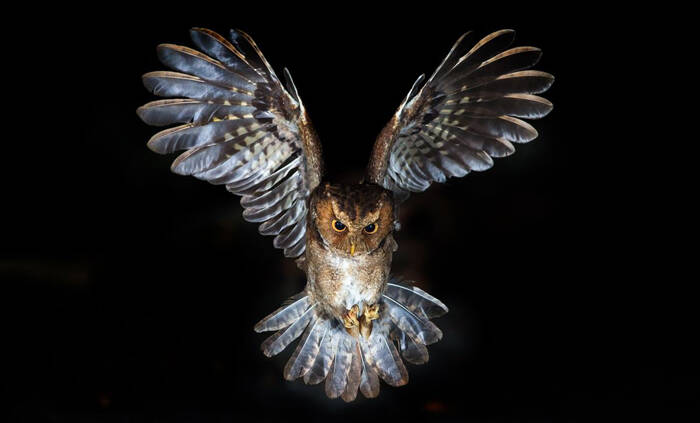Otus spilocephalus
IUCN
LCBasic Information
Scientific classification
- name:Otus spilocephalus
- Scientific Name:Otus spilocephalus,Mountain Scops-owl
- Outline:Raptor
- Family:Strigiformes Strigiformes Owl
Vital signs
- length:18-21cm
- Weight:About 100-150g
- lifetime:No verification information
Feature
There are no obvious vertical or horizontal stripes, only a row of large triangular white spots on the shoulders.
Distribution and Habitat
Distributed in Bangladesh, Bhutan, Cambodia, China, India, Indonesia, Lao People's Democratic Republic, Malaysia, Myanmar, Nepal, Pakistan, Thailand and Vietnam.
In China, it is distributed in Fujian, Taiwan, Guangdong, Hainan, Guangxi and Yunnan.
It mainly lives in mountain evergreen broad-leaved forests and mixed forests below 2,000 meters above sea level, and sometimes also in the forest edge area at the foot of the mountain.
Appearance
The ear feather tufts of the yellow-billed owl are quite conspicuous, and the color is tan with narrow black horizontal spots. The face plate is also tan, with black horizontal spots, and the lower edge is decorated with white. The upper body, including both wings and tail coverts, are mostly brown, decorated with dark brown beetle-like fine lines; the back of the neck has no collar or the collar is not obvious; the outer part of the shoulder feathers is white, and is black near the tip, and forms on the shoulders A white patch. The small wing feathers are dark brown with 4 light yellow spots on the outer wings. The primary flight feathers are dark brown, with light yellow spots near the base of the inner feathers. The outer feathers are light brown and chestnut. Except for the first one which has light chestnut horizontal spots, the second to seventh ones have white and chestnut horizontal spots. The rest The outer flight feathers are maroon and the inner ones are dark brown; the lowe
Details
The Yellow-billed Scops Owl is a small bird with 8 subspecies.

The Yellow-billed Scops Owl is a resident bird. It is nocturnal and mainly active at night and dusk. It hides in dark leaves or caves during the day. Mostly live alone or in pairs. They mainly feed on rodents, lizards, large insects and insect larvae. The call is a continuous rising two-syllable whistle, like "shh, shh-shh, shh-".
The breeding season of the yellow-billed scops owl is from April to June. Usually nesting in natural tree holes or holes abandoned by woodpeckers. Each nest usually lays 3-4 eggs, sometimes as many as 5 and as few as 2. The size of the egg is 31-34 mm × 27-29 mm, with an average of 32 mm × 28 mm.
In October 2021, Lin Xiao, secretary general of the Xiamen Bird Watching Association, and his wife were observing at night when they accidentally discovered a yellow-billed scops owl standing on a low branch near the roadside. It is reported that the Yellow-billed Scops Owl is a national second-class protected animal. This is the first time that this bird species has been observed in Xiamen, breaking the record of wild bird species in Xiamen.
Listed in the list of China's national key protected wild animals, it is a second-class protected bird in China.
Listed in Appendix II of the Washington Convention CITES in 1995.
Listed in the 2012 Red List of Endangered Species of the World Conservation Union (IUCN) ver 3.1-Least Concern (LC).
Protect wild animals and stop eating game.
Maintaining ecological balance is everyone's responsibility!








